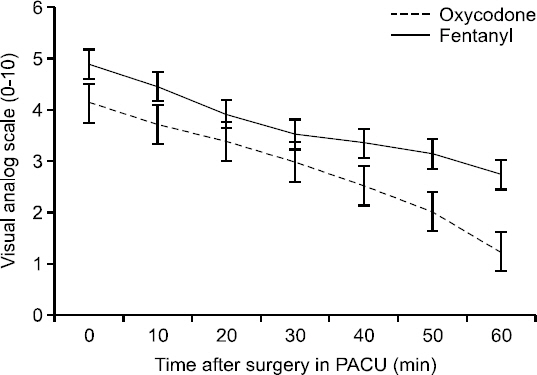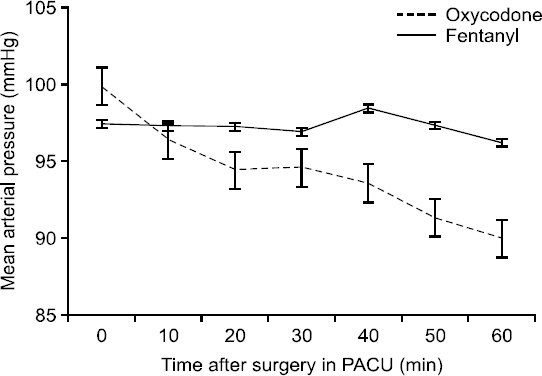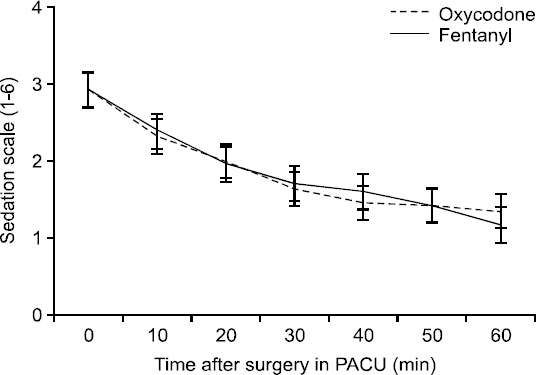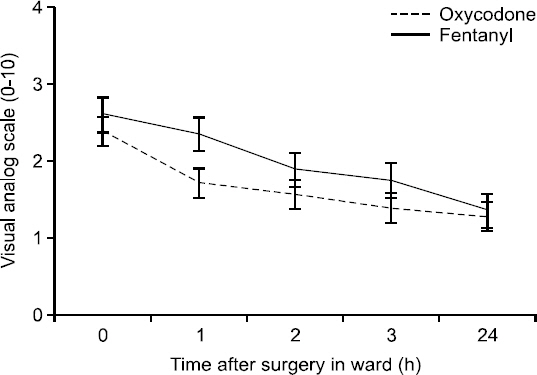Anesth Pain Med.
2016 Apr;11(2):176-181. 10.17085/apm.2016.11.2.176.
A comparison of oxycodone and fentanyl in the management of early postoperative pain and for patient-controlled analgesia after total abdominal hysterectomy
- Affiliations
-
- 1Department of Anesthesiology and Pain Medicine, Gangneung Asan Hospital, University of Ulsan College of Medicine, Gangneung, Korea. hug77779@gmail.com
- KMID: 2358481
- DOI: http://doi.org/10.17085/apm.2016.11.2.176
Abstract
- BACKGROUND
Although oxycodone has been known to be superior to other opioids in postoperative care, few studies have compared its analgesic potency with that of fentanyl. We therefore examined these two drugs in terms of their dose requirements, effects on pain intensity, time needed for relief of pain, and side effects after surgery.
METHODS
We enrolled 56 healthy women scheduled for total abdominal hysterectomy and randomly allocated them to either oxycodone or fentanyl. The opioids were administered to the two groups 10 minutes before the end of the operation. In the post-anesthesia care unit (PACU) after surgery, a visual analog scale (VAS) was used to assess the patients' pain every 10 minutes Whenever pain control was required, a bolus of the same dose of the respective drugs was repeated at 10-minute intervals. Patient-controlled analgesia (PCA) was used to manage postoperative pain. After the patient arrived on the ward, pain scores were recorded at once and then 1, 2, 3, and 24 hours thereafter.
RESULTS
During the hour spent in the PACU, fewer patients in the oxycodone group required the opioid, and the time needed to achieve pain relief was shorter with oxycodone than with fentanyl. Moreover, postoperative VAS levels were significantly lower in the oxycodone group both in the PACU and on the ward (over a 24-hours period). There were no significant differences in side effects between the patients given oxycodone and those given fentanyl.
CONCLUSIONS
Oxycodone was more effective than fentanyl when administered on the basis of the recommended dose ratio (1 : 100). Although further evaluation is needed to investigate the optimal dose ratio, we would recommend a higher conversion factor (1 : 62).
Keyword
MeSH Terms
Figure
Cited by 1 articles
-
Oxycodone vs. fentanyl in the treatment of early post-operative pain after total knee replacement: randomized controlled trial
Su-An Yang, Keun-Sik Kim, Hee Yong Kang
Anesth Pain Med. 2016;11(4):349-353. doi: 10.17085/apm.2016.11.4.349.
Reference
-
1. Gust R, Pecher S, Gust A, Hoffmann V, Böhrer H, Martin E. Effect of patient-controlled analgesia on pulmonary complications after coronary artery bypass grafting. Crit Care Med. 1999; 27:2218–23. DOI: 10.1097/00003246-199910000-00025. PMID: 10548210.
Article2. Howell PR, Gambling DR, Pavy T, McMorland G, Douglas MJ. Patient-controlled analgesia following caesarean section under general anaesthesia: a comparison of fentanyl with morphine. Can J Anaesth. 1995; 42:41–5. DOI: 10.1007/BF03010570. PMID: 7889583.
Article3. Shafer SL, Varvel JR, Aziz N, Scott JC. Pharmacokinetics of fentanyl administered by computer-controlled infusion pump. Anesthesiology. 1990; 73:1091–102. DOI: 10.1097/00000542-199012000-00005. PMID: 2248388.
Article4. Lee GW. A prospective observational cohort study on postoperative intravenous patient-controlled analgesia in surgeries. Anesth Pain Med. 2015; 10:21–6. DOI: 10.17085/apm.2015.10.1.21.
Article5. Koch S, Ahlburg P, Spangsberg N, Brock B, Tønnesen E, Nikolajsen L. Oxycodone vs fentanyl in the treatment of early post-operative pain after laparoscopic cholecystectomy: a randomised double-blind study. Acta Anaesthesiol Scand. 2008; 52:845–50. DOI: 10.1111/j.1399-6576.2008.01643.x. PMID: 18477082.
Article6. Kalso E. Oxycodone. J Pain Symptom Manage. 2005; 29(5 Suppl):S47–56. DOI: 10.1016/j.jpainsymman.2005.01.010. PMID: 15907646.
Article7. Lalovic B, Kharasch E, Hoffer C, Risler L, Liu-Chen LY, Shen DD. Pharmacokinetics and pharmacodynamics of oral oxycodone in healthy human subjects: role of circulating active metabolites. Clin Pharmacol Ther. 2006; 79:461–79. DOI: 10.1016/j.clpt.2006.01.009. PMID: 16678548.
Article8. Ross FB, Smith MT. The intrinsic antinociceptive effects of oxycodone appear to be kappa-opioid receptor mediated. Pain. 1997; 73:151–7. DOI: 10.1016/S0304-3959(97)00093-6.9. Smith MT. Differences between and combinations of opioids re-visited. Curr Opin Anaesthesiol. 2008; 21:596–601. DOI: 10.1097/ACO.0b013e32830a4c4a. PMID: 18784485.
Article10. Nozaki C, Saitoh A, Tamura N, Kamei J. Antinociceptive effect of oxycodone in diabetic mice. Eur J Pharmacol. 2005; 524:75–9. DOI: 10.1016/j.ejphar.2005.09.051. PMID: 16256106.
Article11. Scott JC, Stanski DR. Decreased fentanyl and alfentanil dose requirements with age. A simultaneous pharmacokinetic and pharmacodynamic evaluation. J Pharmacol Exp Ther. 1987; 240:159–66. DOI: 10.1097/00132586-198710000-00044.
Article12. Brittain GJ. Dihydrohydroxycodeinone pectinate. Lancet. 1959; 2:544–6. DOI: 10.1016/S0140-6736(59)91781-7.
Article13. Silvasti M, Rosenberg P, Seppälä T, Svartling N, Pitkänen M. Comparison of analgesic efficacy of oxycodone and morphine in postoperative intravenous patient-controlled analgesia. Acta Anaesthesiol Scand. 1998; 42:576–80. DOI: 10.1111/j.1399-6576.1998.tb05169.x. PMID: 9605375.
Article14. Kalso E, Vainio A. Morphine and oxycodone hydrochloride in the management of cancer pain. Clin Pharmacol Ther. 1990; 47:639–46. DOI: 10.1038/clpt.1990.85. PMID: 2188774.
Article15. Staahl C, Dimcevski G, Andersen SD, Thorsgaard N, Christrup LL, Arendt-Nielsen L, et al. Differential effect of opioids in patients with chronic pancreatitis: an experimental pain study. Scand J Gastroenterol. 2007; 42:383–90. DOI: 10.1080/00365520601014414. PMID: 17354119.
Article16. Morrison JD, Loan WB, Dundee JW. Controlled comparison of the efficacy of fourteen preparations in the relief of postoperative pain. Br Med J. 1971; 3:287–90. DOI: 10.1136/bmj.3.5769.287. PMID: 4934047. PMCID: PMC1799136.
Article17. Kalso E, Pöyhiä R, Onnela P, Linko K, Tigerstedt I, Tammisto T. Intravenous morphine and oxycodone for pain after abdominal surgery. Acta Anaesthesiol Scand. 1991; 35:642–6. DOI: 10.1111/j.1399-6576.1991.tb03364.x. PMID: 1785245.
Article18. Pereira J, Lawlor P, Vigano A, Dorgan M, Bruera E. Equianalgesic dose ratios for opioids. a critical review and proposals for long-term dosing. J Pain Symptom Manage. 2001; 22:672–87. DOI: 10.1016/S0885-3924(01)00294-9.19. Kokki M, Broms S, Eskelinen M, Rasanen I, Ojanperä I, Kokki H. Analgesic concentrations of oxycodone--a prospective clinical PK/PD study in patients with laparoscopic cholecystectomy. Basic Clin Pharmacol Toxicol. 2012; 110:469–75. DOI: 10.1111/j.1742-7843.2011.00839.x. PMID: 22136407.20. Camu F, Vanlersberghe C. Pharmacology of systemic analgesics. Best Pract Res Clin Anaesthesiol. 2002; 16:475–88. DOI: 10.1053/bean.2002.0262. PMID: 12516886.
Article21. Choi BM. Oxycodone: a new therapeutic option in postoperative pain management. J Korean Dent Soc Anesthesiol. 2013; 13:167–78.
Article22. Saari TI, Ihmsen H, Neuvonen PJ, Olkkola KT, Schwilden H. Oxycodone clearance is markedly reduced with advancing age: a population pharmacokinetic study. Br J Anaesth. 2012; 108:491–8. DOI: 10.1093/bja/aer395. PMID: 22201184.
Article23. Scott JC, Stanski DR. Decreased fentanyl and alfentanil dose requirements with age. A simultaneous pharmacokinetic and pharmacodynamic evaluation. J Pharmacol Exp Ther. 1987; 240:159–66. DOI: 10.1097/00132586-198710000-00044.
Article
- Full Text Links
- Actions
-
Cited
- CITED
-
- Close
- Share
- Similar articles
-
- Comparison of oxycodone and fentanyl for postoperative patient-controlled analgesia after laparoscopic gynecological surgery
- Comparison of oxycodone and fentanyl for postoperative patient-controlled analgesia after orthopedic surgery
- A new therapeutic option for postoperative pain management with oxycodone HCI injection
- A comparison of oxycodone and fentanyl in intravenous patient-controlled analgesia after laparoscopic hysterectomy
- Oxycodone versus Fentanyl for Intravenous Patient-Controlled Analgesia after Laparoscopic Gynecologic Surgery





